Notre-Dame de la Garde – “The Good Mother”
- Written by Portal Editor
Today began with a decision that, in retrospect Notre Dame de la Garde turned out to be quite the right one: taking the tourist train up to the La Garde hill, which is only 161 meters high, where there is said to be such a perfect view of Marseilles and of course the St. Mary's pilgrimage church is worth visiting.
Not that it was too hot to hike up the hill through the city's narrow streets, as it's only 1.3 kilometers from La Vieux Port to the cathedral. We wanted to go to Plage des Catalans later and so used the tourist train that passed the beach area. In this way, we thought, we could get a first impression of the beach area. Not as exciting as we saw a little later.
Tourist train “Les Petits Trains de Marseilles” up to Notre-Dame de la Garde
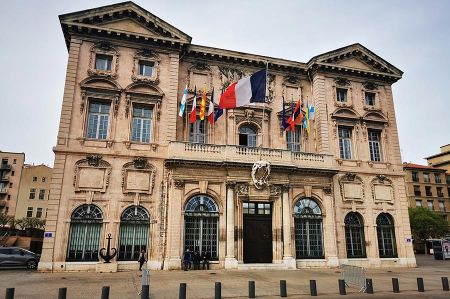 The tourist train “Les Petits Trains de Marseilles” starts at the Quai du Port, approximately at the level of the old town hall, and then circles the harbor basin along the Plage des Catalans beach to approximately La Corniche Kennedy, where it turns left through fairly narrow streets up to the La hill Guard leaves. On the roughly triangular rocky plateau of the Notre-Dame de la Garde hill, which later gave the church its nickname, a Marseille priest Pierre had a small Lady Chapel built in 1214. Even after an expansion in 1477, it did not hold more than 60 people. From 1524, Francis I had the La Garde hill expanded into a military fortification at the same time as the island fortress Château d'If. The Lady Chapel, now within the fortifications, remained accessible to civilian visitors via a drawbridge. The number of pilgrims increased steadily because since around 1600, Notre-Dame de la Garde had also been a church of prayer and thanksgiving for sailors.
The tourist train “Les Petits Trains de Marseilles” starts at the Quai du Port, approximately at the level of the old town hall, and then circles the harbor basin along the Plage des Catalans beach to approximately La Corniche Kennedy, where it turns left through fairly narrow streets up to the La hill Guard leaves. On the roughly triangular rocky plateau of the Notre-Dame de la Garde hill, which later gave the church its nickname, a Marseille priest Pierre had a small Lady Chapel built in 1214. Even after an expansion in 1477, it did not hold more than 60 people. From 1524, Francis I had the La Garde hill expanded into a military fortification at the same time as the island fortress Château d'If. The Lady Chapel, now within the fortifications, remained accessible to civilian visitors via a drawbridge. The number of pilgrims increased steadily because since around 1600, Notre-Dame de la Garde had also been a church of prayer and thanksgiving for sailors.
Notre-Dame de la Garde – a pilgrimage church
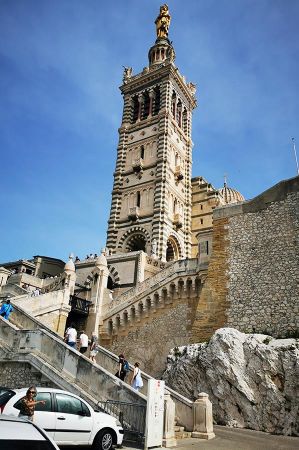 Notre-Dame de la Garde, popularly known as La Bonne Mère – “the good mother”, is a Marian pilgrimage church. It is visited by two million people every year, which we can only confirm, because on the day we visited there was also a dense crowd and one or two devotions, so that the visitors had to wait a long time to get in. Parked cars everywhere, with tourist trains continually arriving in between, each bringing around 50 guests.
Notre-Dame de la Garde, popularly known as La Bonne Mère – “the good mother”, is a Marian pilgrimage church. It is visited by two million people every year, which we can only confirm, because on the day we visited there was also a dense crowd and one or two devotions, so that the visitors had to wait a long time to get in. Parked cars everywhere, with tourist trains continually arriving in between, each bringing around 50 guests.
Not to mention the buses. The neo-Romanesque-Byzantine church was built on the site of a medieval chapel from 1853 according to plans by Henri-Jacques Espérandieu and consecrated on June 4, 1864 by the Curial Cardinal Clément Villecourt. The construction had to be interrupted several times due to lack of money. In 1861 the crypt carved into the rock was completed.
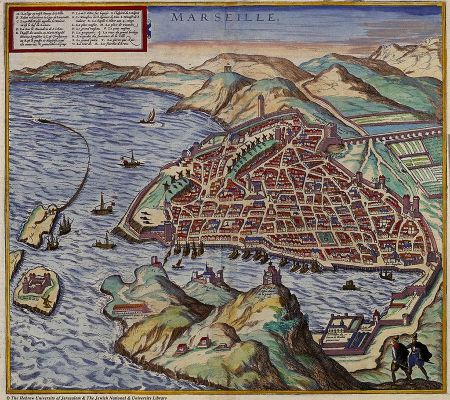 The basilica faces southeast. In the northwest, above the double staircase that leads down to the city, is the square bell tower with the main portal crowned with statues. The dimensions of the church are relatively modest, the external length is only 52.50 m, the external width is only 16.80 m. The tower is 41 m high up to the angel gallery. With the figure of the Virgin Mary and the lantern she carries, it reaches a height of 65 m.
The basilica faces southeast. In the northwest, above the double staircase that leads down to the city, is the square bell tower with the main portal crowned with statues. The dimensions of the church are relatively modest, the external length is only 52.50 m, the external width is only 16.80 m. The tower is 41 m high up to the angel gallery. With the figure of the Virgin Mary and the lantern she carries, it reaches a height of 65 m.
At the solemn consecration of the upper church, which Cardinal Villecourt carried out in June 1864 in the presence of 41 bishops, the bell tower was still unfinished. It was not until 1866 that the large Marie-Joséphine bell found its place there. This was followed by the production and installation of the 11.20 m high statue of the Virgin Mary on the top of the tower, a design by Eugène-Louis Lequesne, executed by the Christofle company as a fire-gilded electroplated sculpture. It was completed in 1870.
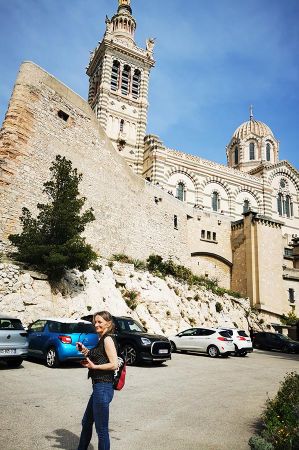 Inside the cathedral of Notre Dame de la Garde, what is particularly impressive is the rich figurative and ornamental mosaic decoration on a gold background, which is based on models from Ravenna and Rome. For us, once again, too much pomp and splendor when there is so much hunger and misery in the world. But there are other views on this too. The mosaics cover the entire apse, the crossing and nave domes as well as the side chapels. In the upper church and in the crypt there are a total of five statues of the Virgin Mary from different eras and materials, as well as other statues of saints that were created by Joseph Marius Ramus. The furnishings also include numerous votive offerings that tell of answered prayers.
Inside the cathedral of Notre Dame de la Garde, what is particularly impressive is the rich figurative and ornamental mosaic decoration on a gold background, which is based on models from Ravenna and Rome. For us, once again, too much pomp and splendor when there is so much hunger and misery in the world. But there are other views on this too. The mosaics cover the entire apse, the crossing and nave domes as well as the side chapels. In the upper church and in the crypt there are a total of five statues of the Virgin Mary from different eras and materials, as well as other statues of saints that were created by Joseph Marius Ramus. The furnishings also include numerous votive offerings that tell of answered prayers.
From the perspective of architecture and statics, the basilica is a pillar church with a rectangular floor plan. The main nave has three bays, which are flanked by chapels instead of side aisles and vaulted with flat domes hidden under the gable roof. The main dome on an octagonal tambourine, which is visible from the outside, stands above an only hinted crossing, which is immediately followed by the apse. The masonry consists of layers of contrasting colours inside and out, which contribute significantly to the oriental character of the building.
French Revolution ends medieval miraculous image
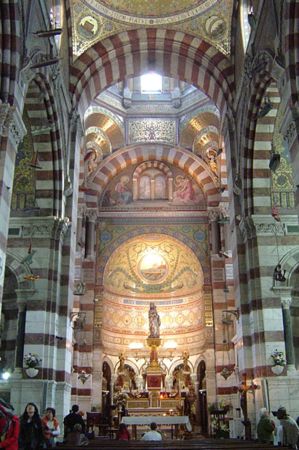 During the French Revolution, the church lost its medieval image, all its furnishings and the bells. It was not until 1807 that it was reopened for worship and gradually restored. In 1837 Jean-Baptiste Chanuel created a new large silver statue of Our Lady with the Child, which now stands in the new basilica above the main altar. In 1845 the small mountain chapel received a huge bell, called Marie-Joséphine, weighing 8234 kg, for which a separate bell tower was built.
During the French Revolution, the church lost its medieval image, all its furnishings and the bells. It was not until 1807 that it was reopened for worship and gradually restored. In 1837 Jean-Baptiste Chanuel created a new large silver statue of Our Lady with the Child, which now stands in the new basilica above the main altar. In 1845 the small mountain chapel received a huge bell, called Marie-Joséphine, weighing 8234 kg, for which a separate bell tower was built.
In 1851, the rector of Notre Dame de la Garde finally submitted a request to the War Ministry in Paris to be allowed to build a larger new building with a high tower in place of the old church within the military complex. Approval was granted, and after the decision had been made in favour of the 23-year-old Protestant architect Espérandieu and his Romano-Byzantine design - the competing design envisaged neo-Gothic forms - the cornerstone of the building was laid on September 11, 1853 by Bishop Eugène de Mazenod Building laid in its current form.
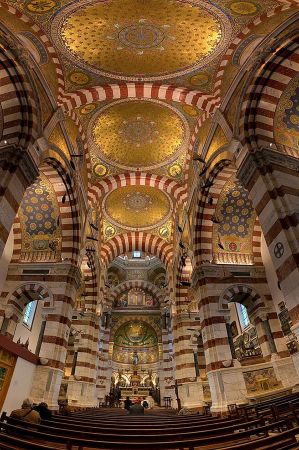 During the First World War it became clear that the bastions of La Garde no longer had any military value. After many years of negotiations with the War Ministry, the Archdiocese of Marseilles was able to purchase the entire facility and convert it for its purposes.
During the First World War it became clear that the bastions of La Garde no longer had any military value. After many years of negotiations with the War Ministry, the Archdiocese of Marseilles was able to purchase the entire facility and convert it for its purposes.
In June 1931, to celebrate the 1500th anniversary of the Council of Ephesus with the Theotokos Proclamation, the silver statue of the Virgin Mary was commissioned by Pope Pius XI by Chanuel. crowned by Cardinal Louis-Joseph Maurin in the presence of 49 bishops and 300,000 faithful.
Notre-Dame de la Garde – The "Good Mother" of Marseille - more details
A landmark above the city
It towers high above Marseille – proud, radiant, and protective: Notre-Dame de la Garde, affectionately called "La Bonne Mère" by the locals. Visitors to Marseille simply cannot miss this magical place.
The significance of Notre-Dame de la Garde
It is much more than just a building. For the people of Marseille, it is a beacon of hope, a guardian angel, and an integral part of everyday life.
The affectionate nickname "La Bonne Mère"
"The Good Mother" – a name that reflects the deep trust the people of Marseille have in their patron saint.
Where is Notre-Dame de la Garde?
A hill with a panoramic view
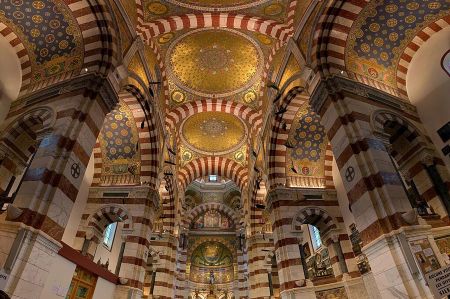 Located on the 149-meter-high Garde Hill, the basilica offers breathtaking views of the city, sea, and coast.
Located on the 149-meter-high Garde Hill, the basilica offers breathtaking views of the city, sea, and coast.
Directions and routes to the Basilica
Whether on foot, by bus, or the tourist train – many paths lead to the top. A little effort is definitely worth it!
History of the Basilica
Origins in the Middle Ages
As early as the 13th century, a small chapel was built on this site, which was later expanded into a mighty basilica.
New Buildings in the 19th Century
In 1864, the current basilica was consecrated in the Neo-Byzantine style – magnificent, detailed, and imposing.
Architectural Features
The Byzantine Style
Golden mosaics, magnificent arches, and colourful stones characterize the interior of the basilica and transport visitors to another world.
Interior full of symbolism
Models of ships hang from the ceiling – as a thank you from sailors for their rescue from distress at sea.
The Golden Statue of the Virgin Mary
Patron Saint of Sailors
An 11-meter-high golden statue of the Virgin Mary sits enthroned on the spire, watching over the city and the sea.
A shining landmark
Even from afar, it glows in the sun and welcomes sailors and visitors.
Spiritual significance
Place of pilgrimage for the locals
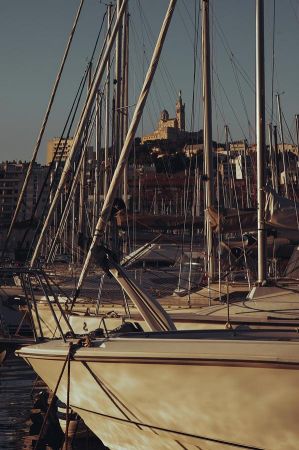 Many Marseille residents regularly make pilgrimages to the "Good Mother," whether to pray or simply to reflect.
Many Marseille residents regularly make pilgrimages to the "Good Mother," whether to pray or simply to reflect.
Traditions and festivals
Solemn processions take place, especially on August 15th, the Feast of the Assumption.
The view from Notre-Dame de la Garde
View of Marseille and the sea
Whether day or night – the view from up here is simply breathtaking!
Magical sunsets
As the sun slowly sinks into the Mediterranean, the sky transforms into a sea of colour.
The role of Marseille residents in everyday life
A place for prayers and wishes
Whether large requests or small hopes – Notre-Dame de la Garde is a place of contact for many in all situations.
A sign of hope
In times of crisis, the "Bonne Mère" was and remains a symbol of confidence for the city.
Special events and celebrations
Processions and religious festivals
At Easter, Christmas, or on August 15th, the basilica transforms into a centre of lived spirituality.
Significant anniversaries
Commemorations of important historical events are solemnly celebrated here.
Practical tips for your visit
Best times to visit
Early morning or evening are most pleasant – fewer tourists and particularly atmospheric lighting.
Admission, opening hours, and recommendations
Admission is free, donations are welcome. The basilica is open daily, usually from 7:00 a.m. to 6:00 p.m.
Culinary Discoveries Around the Basilica
Restaurants and Cafés with a View
There are numerous charming restaurants nearby, offering Provençal delicacies and magnificent views.
Try Marseille Specialties
Be sure to try: Bouillabaisse, the famous fish soup, or freshly baked fougasse.
Other Nearby Attractions
Old Port (Vieux-Port)
Just a few minutes away is the vibrant heart of Marseille – perfect for a stroll.
Le Panier – Marseille's Oldest District
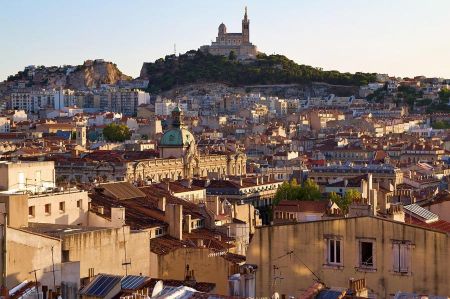 Winding alleys, colourful houses, and plenty of authentic flair await you here.
Winding alleys, colourful houses, and plenty of authentic flair await you here.
Why Notre-Dame de la Garde is an Absolute Must-See
No other place combines spirituality, history, and breathtaking views as perfectly as the "Good Mother" on the Garde Hill.
Conclusion – Magic on the Hill of Marseille
Notre-Dame de la Garde is far more than a landmark – it is the heart, soul, and pride of Marseille. Those who have been here not only take-home beautiful pictures, but also deep impressions.
FAQs about Notre-Dame de la Garde
1. What is the best way to get to the basilica?
The most convenient way is by bus or the small tourist train from Vieux-Port.
2. Do I have to pay an entrance fee?
No, admission to the basilica is free.
3. Can you climb the tower?
Unfortunately, not but the square around the basilica offers a fantastic view.
4. Are there souvenir shops on site?
Yes, small shops around the basilica sell religious memorabilia and local products.
5. Is Notre-Dame de la Garde wheelchair accessible?
The basilica is partially wheelchair accessible, and assistance is available on site.
Please also read:
One afternoon in Sirince...vineyards to see!
Short visit to the Tara – French research schooner
-
 Notre Dame de la Garde in Marseille
Notre Dame de la Garde in Marseille
Notre Dame de la Garde in Marseille
Notre Dame de la Garde in Marseille
-
 Notre Dame de la Garde in Marseille
Notre Dame de la Garde in Marseille
Notre Dame de la Garde in Marseille
Notre Dame de la Garde in Marseille
-
 Notre Dame de la Garde in Marseille
Notre Dame de la Garde in Marseille
Notre Dame de la Garde in Marseille
Notre Dame de la Garde in Marseille
-
 Notre Dame de la Garde in Marseille
Notre Dame de la Garde in Marseille
Notre Dame de la Garde in Marseille
Notre Dame de la Garde in Marseille
-
 Notre Dame de la Garde in Marseille
Notre Dame de la Garde in Marseille
Notre Dame de la Garde in Marseille
Notre Dame de la Garde in Marseille
-
 Notre Dame de la Garde in Marseille
Notre Dame de la Garde in Marseille
Notre Dame de la Garde in Marseille
Notre Dame de la Garde in Marseille
https://www.alaturka.info/en/france/marseilles/6611-notre-dame-de-la-garde-the-good-mother#sigProIdcdbc9b63db

